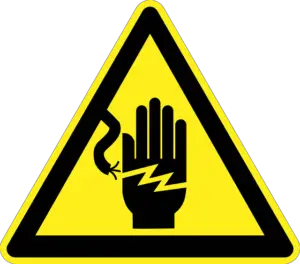When operating electrical equipment, there is a long-standing tradition among electricians to use their left hand, stand to the right of the equipment, and operate the handle in a swift and decisive movement.
This practice is commonly referred to as the Electrician’s Left-Hand Rule and has been drilled into electricians for over a century.
However, in recent years, some have challenged this rule, suggesting that it may be safer to operate the equipment with the right hand, placing the body directly in front of the equipment, and relying on the metal door to protect against arc flashes.
This article will explore the debate over the Electrician’s Left-Hand Rule and which approach is safer when operating electrical equipment.
Table of Contents
The Electrician’s Left-Hand Rule:
The Electrician’s Left-Hand Rule is based on the principle that the left hand is less likely to make accidental contact with a live part of the equipment, reducing the risk of electrical shock.
Standing to the right of the equipment and facing away from it also provides a clear line of sight to the handle, allowing for a swift and decisive movement.
This approach has been drilled into electricians for generations and has a long history of use.
What OSHA, NFPA, and IEEE are saying
- OSHA: “To open an electrical enclosure or control panel, use your left hand to pull the door open while standing to the right of the enclosure. This practice will help protect you in case of an arc flash or electrical explosion, which can throw objects and debris to the right.” (Source: OSHA Fact Sheet – Electrical Safety, 2019)
- NFPA 70E: “When accessing electrical equipment that requires the opening of doors or covers, position yourself to the side of the equipment, and use one hand to reach around the door or cover to grasp the handle or knob on the opposite side. Open the door or cover by pushing or pulling it slightly and then applying enough force to fully open it. The hand used to open the door or cover should be removed quickly to avoid accidental contact with energized components inside the equipment.” (Source: NFPA 70E – Standard for Electrical Safety in the Workplace, 2021 Edition)
- IEEE: “The Left-Hand Rule is a well-established industry practice that involves using your left hand to operate equipment controls, leaving your right hand free to react in case of an electrical shock or explosion. This rule applies to any electrical equipment, including panelboards, circuit breakers, and disconnect switches.” (Source: IEEE Electrical Safety Committee – Recommended Practice for Electrical Safety in Industrial and Commercial Power Systems, 2021 Edition)
here are the links to the sources:
- OSHA Fact Sheet – Electrical Safety: https://www.osha.gov/Publications/osha3075.pdf
- NFPA 70E – Standard for Electrical Safety in the Workplace: https://www.nfpa.org/codes-and-standards/all-codes-and-standards/list-of-codes-and-standards/detail?code=70E
- IEEE Electrical Safety Committee – Recommended Practice for Electrical Safety in Industrial and Commercial Power Systems: https://standards.ieee.org/standard/3004-8–2021.html
The Advent of Arc Flash Awareness:

In recent years, the importance of arc flash awareness has been emphasized in the electrical industry.
An arc flash is a sudden, explosive release of electrical energy that can occur when a fault develops in an electrical system.
The intense heat and pressure generated by an arc flash can cause severe burns, injuries, and even fatalities.
As a result, there has been a growing focus on preventing arc flashes and protecting workers from their harmful effects.
The Challenge to the Electrician’s Left-Hand Rule:
With the growing awareness of arc flashes, some have challenged the Electrician‘s Left-Hand Rule, suggesting that it may be safer to operate equipment with the right hand, placing the body directly in front of the equipment.
The rationale behind this approach is that the metal door of the equipment will provide protection in the event of an arc flash, shielding the worker from harm.
However, this approach has not been widely adopted and has generated some debate among electricians and safety professionals.
The Risks of Challenging the Electrician’s Left-Hand Rule:
While the metal door of the equipment may provide some protection in the event of an arc flash, relying on it as a primary safety measure is not without risks.
For one, the metal door may not always provide adequate protection, especially if the arc flash is particularly intense or if the door is damaged or compromised.
Additionally, reaching across the front of the equipment and placing the body in front of it increases the risk of accidental contact with live parts, especially if the worker is not properly trained or if the equipment is not properly labeled or de-energized.
Read also my article: Shocking Safety: How Electricians Work on Live Circuits
The Importance of Proper Training and Safety Procedures:
Ultimately, the choice of which approach to use when operating electrical equipment should be based on a thorough assessment of the risks involved, the worker’s level of training and experience, and compliance with applicable safety regulations.
Regardless of which approach is used, it is essential that workers are properly trained in electrical safety procedures, including lockout/tagout, personal protective equipment, and safe work practices.
Additionally, equipment should be properly labeled and de-energized before any maintenance or repairs are performed, and all safety procedures should be strictly followed.
Conclusion:
The debate over the Electrician’s Left-Hand Rule highlights the importance of constantly reevaluating and improving electrical safety practices.
While the left-hand rule has a long history of use and has proven effective in preventing electrical shock, the growing awareness of arc flash risks has prompted some to question its effectiveness.
